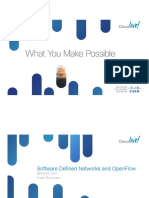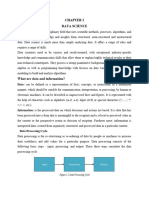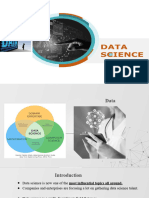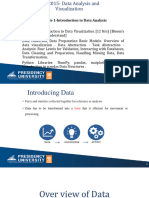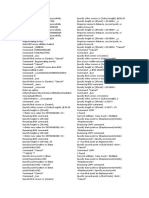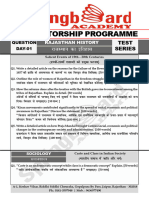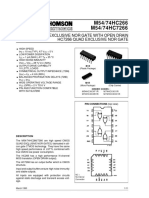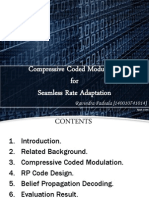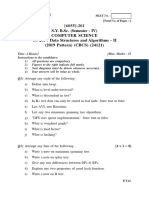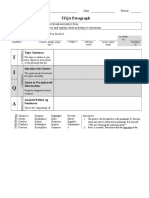Module 3_(Prepare Data for Exploration)
Uploaded by
lostbilla66Module 3_(Prepare Data for Exploration)
Uploaded by
lostbilla66Google data analytics professional course
Week - 1
Collecting Data
Data collection considerations
● How the data will be collected
● Data sources
● Decide what data to use
● How much data to collect
● Select the right data type
● Determine the time frame for data collection
First-party data, This is data collected by an individual or group using their
own resources. Collecting first-party data is typically the preferred method
because you know exactly where it came from.
Second-party data, which is data collected by a group directly from its
audience and then sold. In our example, if you aren't able to collect your own
data, you might buy it from an organization that's led traffic pattern
studies in your city.
Third-party data, or data collected from outside sources who did not
collect it directly. This data might have come from a number of different
sources before you investigated it.
Differentiate between data formats and data
structures
Discover data formats
Two types of data
Quantitative
Qualitative
We can go even deeper into quantitative data and break it down into discrete
or continuous data.
Quantitative
● Discrete data:
This is data that's counted and has a limited number of values.
● Continuous data:
It can be measured using a timer, and its value can be shown as a decimal
with several places.Example You could express that movie's run time as
110.0356 minutes. You could even add fractional data after the decimal point
if you needed to.
Qualitative
● Nominal Eg: yes or no type data
● Ordinal data Eg: Rating between some values
Another types of data:
Internal data,
which is data that lives within a company's own systems.
External data, is, you guessed it, data that lives and is generated outside of
an organization.
Structured data is data that's organized in a certain format, such as rows
and columns.
This also helps make data visualization pretty easy because structured data
can be applied directly to charts, graphs, heat maps, dashboards and most
other visual representations of data.
Unstructured data,
This is data that is not organized in any easily identifiable manner. Audio and
video files are examples of unstructured data because there's no clear way
to identify or organize their content.
Understanding structured data
Data model
A model that is used for organizing data elements and how they relate to
one another.
Data elements
They're pieces of information, such as people's names, account numbers, and
addresses.
The structure of data
Data modeling levels and techniques
Types of data modeling
Data-modeling techniques
There are a lot of approaches when it comes to developing data models, but
two common methods are the Entity Relationship Diagram (ERD) and the
Unified Modeling Language (UML) diagram.
Explore data types, fields and values
Know the type of data you're working with
Data type
A data type is a specific kind of data attribute that tells what kind of value
the data is.
Basic data types:
● String
● Number
● Boolean
Understanding Boolean logic
● AND
● OR
● NOT
Additional Reading/Resources
● https://www.maa.org/press/periodicals/convergence/origins-of-boolean-algebra-in-
the-logic-of-classes-george-boole-john-venn-and-c-s-peirce
● https://libguides.mit.edu/c.php?g=175963&p=1158594
Meet wide and long data
Transforming data
Data transformation is the process of changing the data’s format,
structure, or values. As a data analyst, there is a good chance you will need
to transform data at some point to make it easier for you to analyze it.
Data transformation usually involves:
● Adding, copying, or replicating data
● Deleting fields or records
● Standardizing the names of variables
● Renaming, moving, or combining columns in a database
● Joining one set of data with another
● Saving a file in a different format. For example, saving a spreadsheet
as a comma separated values (CSV) file.
Goals for data transformation might be:
● Data organization: better organized data is easier to use
● Data compatibility: different applications or systems can then use the
same data
● Data migration: data with matching formats can be moved from one
system to another
● Data merging: data with the same organization can be merged together
● Data enhancement: data can be displayed with more detailed fields
● Data comparison: apples-to-apples comparisons of the data can then be
made
Week - 2
Unbiased and objective data
Bias: From questions to conclusions
Bias has evolved to become a preference in favor of or against a person,
group of people, or things.
Data bias is a type of error that systematically skews results in a certain
direction.
Biased and unbiased data
Sampling bias is when a sample isn't representative of the population
as a whole. You can avoid this by making sure the sample is chosen at
random, so that all parts of the population.
Unbiased sampling results in a sample that's representative of the
population being measured.
Understanding bias in data
Three more types of data bias, [ Sampling bias + ]
● observer bias (or Experimenter bias or research bias)
● interpretation bias
● confirmation bias
Observer bias
The tendency for different people to observe things differently.
Interpretation bias
The tendency to always interpret ambiguous situations in a positive, or
negative way. Eg: Communicating with friend and manager same content but
different understanding.
Confirmation bias
It is the tendency to search for, or interpret information in a way that
confirms preexisting beliefs.
Explore data credibility
Identifying good data sources
ROCCC
● R- Reliable
● O- Original
● C- Comprehensive
● C- Current
● C- Cited
For good data, stick with vetted public data sets,academic papers, financial
data and governmental agency data.
What is "bad" data?
Not ROCCC
Data ethics and privacy
Introduction to data ethics
Ethics refers to well-founded standards of right and wrong that prescribe
what humans ought to do, usually in terms of rights, obligations, benefits to
society, fairness or specific virtues.
Data ethics refers to well- founded standards of right and wrong that
dictate how data is collected, shared, and used.
GDPR - General Data Protection Regulation of the European Union
There are lots of different aspects of data ethics but we'll cover six:
● ownership,
● transaction transparency,
● consent,
● currency,
● privacy, and
● openness.
Ownership
Individuals who own the raw data they provide, and they have primary
control over its usage, how it's processed and how it's shared.
Transaction transparency
Which is the idea that all data processing activities and algorithms should
be completely explainable and understood by the individual who provides
their data.
Consent
This is an individual's right to know explicit details about how and why
their data will be used before agreeing to provide it. They should know
answers to questions like why is the data being collected? How will it be
used? How long will it be stored? The best way to give consent is probably a
conversation between the person providing the data and the person
requesting it.
Currency
Individuals should be aware of financial transactions resulting from the
use of their personal data and the scale of these transactions.
Privacy means preserving a data subject's information and activity any
time a data transaction occurs.
● Protection from unauthorized access to our private data,
● Freedom from inappropriate use of our data,
● The right to inspect, update, or correct our data,
● Ability to give consent to use our data,and
● Legal right to access our data.
Data anonymization
Personally identifiable information - PII
Data anonymization
Data anonymization is the process of protecting people's private or
sensitive data by eliminating that kind of information. Typically, data
anonymization involves blanking, hashing, or masking personal information,
often by using fixed-length codes to represent data columns, or hiding data
with altered values.
What types of data should be anonymized?
Healthcare and financial data are two of the most sensitive types of data.
These two industries usually goes through de-identification, which is a
process used to wipe data clean of all personally identifying information.
Data anonymization is used in just about every industry.
● Telephone numbers
● Names
● License plates and license numbers
● Social security numbers
● IP addresses
● Medical records
● Email addresses
● Photographs
● Account numbers
Understanding open data
Openness refers to free access, usage and sharing of data.preferably by
downloading over the Internet in a convenient and modifiable form.
Eg:data.gov
● Be available and accessible to the public as a complete dataset
● Be provided under terms that allow it to be reused and redistributed
● Allow universal participation so that anyone can use, reuse, and
redistribute the data
Data Interoperability is the ability of data systems and services to openly
connect and share data.
Sites and resources for open data
● https://www.data.gov/
● https://www.census.gov/data.html
● https://www.opendatanetwork.com/
● https://cloud.google.com/solutions/datasets
● https://datasetsearch.research.google.com/
Week-3
Working with databases
All about databases
Database
A database is a collection of data stored in a computer system.
Metadata
Metadata is data about data.
Database features
Relational database
A relational database is a database that contains a series of related tables
that can be connected via their relationships.
Primary key
A primary key is an identifier that references a column in which each value
is unique.
A table can only have one primary key.
Foreign key
A foreign key is a field within a table that's a primary key in another table.
A table in a relational database is allowed to have multiple foreign keys.
Managing data with metadata
Exploring metadata
Metadata summarizes basic information about data.
There are three common types of metadata:
● descriptive,
● structural, and
● administrative
Descriptive metadata:
It is metadata that describes a piece of data and can be used to
identify it at a later point in time.
Eg: The descriptive metadata of a book in a library would include the code
you see on its spine, known as a unique International Standard Book Number,
also called the ISBN.
Structural metadata
Which is metadata that indicates how a piece of data is organized and
whether it's part of one or more than one data collection.
Eg: Index of a book
Administrative metadata
It is metadata that indicates the technical source of a digital asset.
Eg: Details of the photo includes size, time, height, width etc..
Metadata is as important as the data itself
Metadata tells the who, what, when, where, which, how, and why of data.
Elements of metadata
● Title and description
● Tags and categories
● Who created it and when
● Who last modified it and when
● Who can access or update it
Using metadata as an analyst
A metadata repository is a database specifically created to store metadata.
Analysts use meta data because it tells what the data is.
Metadata management
Data governance is a process to ensure the formal management of a
company’s data assets.
Accessing different data sources
Working with more data sources
● Internal
● External
Internal data from internal source
Data from spreadsheet to spreadsheet
Eg:
=IMPORTRANGE("https://docs.google.com/spreadsheets/d/1utuuy9wrDP0g6TbkBzZgKIU6qVzPV7q2dL
Km5urU_x4/edit#gid=0", "A1:O12")
From external source to a spreadsheet
Import from files like csv, xlsx etc..
or
Spreadsheet - IMPORTHTML(“ url ”, ” table ”, 1)
GUIDE
● https://www.thedataschool.co.uk/anna-prosvetova/web-scraping-made
-easy-import-html-tables-or-lists-using-google-sheets-and-excel/
TABLE IN WEBSITE
● https://en.wikipedia.org/wiki/Demographics_of_India
Eg:
=IMPORTHTML("http://en.wikipedia.org/wiki/Demographics_of_India","tabl
e",1)
● We can draw data only from table or list.
● The number is the index that refers to the order of the tables on a
web page.
Microsoft Excel
You can import data from web pages using the From Web option:
Step 1: Open a new or existing spreadsheet.
Step 2: Click Data in the main menu and select the From Web option.
Step 3: Enter the URL and click OK.
Step 4: In the Navigator, select which table to import.
Step 5: Click Load to load the data from the table into your spreadsheet.
Importing data from spreadsheets and databases
Data from the websites
https://www.who.int/data/gho/
Exploring public datasets
● https://cloud.google.com/solutions/datasets
● https://datasetsearch.research.google.com/
● https://www.kaggle.com/datasets
● https://cloud.google.com/bigquery/public-data
Public health datasets
● https://www.who.int/data/collections
● https://cloud.google.com/healthcare/docs/resources/public-datasets/
tcia
● https://cloud.google.com/life-sciences/docs/resources/public-dataset
s/1000-genomes
Public climate datasets
● https://www.climate.gov/maps-data/all?listingMain=datasetgallery
● https://www.ncei.noaa.gov/weather-climate-links
Public social-political datasets
● https://data.unicef.org/resources/dataset/sowc-2019-statistical-t
ables/
● https://www.bls.gov/cps/tables.htm
● https://openpolicing.stanford.edu/
Sorting and filtering
Sort and filter in spreadsheet
Working with large datasets in SQL
Bigquery commands
SELECT
FROM
WHERE
SELECT
count(*) as num_of_bikestrips or count(duration) as num_of_bikestrips
FROM
`bigquery-public-data.london_bicycles.cycle_hire`
WHERE
duration >= 1200;
SELECT
name,
count
FROM
`babynames.names_2014`
WHERE
gender = 'M'
ORDER BY
count DESC //count in descending order
LIMIT
5
IN-Depth Bigquery
Dialects
Vendors of SQL databases may use slightly different variations of SQL.
These variations are called SQL dialects.
● MySQL, PostgreSQL, and SQL Server, aren’t case sensitive. This
means if you searched for country_code = ‘us’, it will return all entries
that have 'us', 'uS', 'Us', and 'US'.
● BigQuery is case sensitive, so that same search would only return
entries where the country_code is exactly 'us'.
● We can use single or double quotations ‘ ‘ or “ “ .
-- command line
Write neatly
Multi line command
Week-4
Effectively organize data
Benefits of organize data
● It makes it easier to find and use,
● Helps you avoid making mistakes during your analysis and
● Helps to protect it.
Best practices you can use when organizing data, including
● Naming conventions,
● Foldering, and
● Archiving older files.
● Align your naming and storage practices with your team to avoid any
confusion
● Develop metadata practices
All about file naming
Naming conventions
That describes the content, date, or version of a file and its name.
Securing data
Data security
Data Security means protecting data from unauthorized access or
corruption by adopting safety measures.
Balancing security and analytics
Encrypt data after analysis
Week-5
Create or enhance your online presence
Why an online presence is important
A professional online presence
● It can help potential employers find you.
● lets you make connections with other data analysts in your field,
● learn and share data findings, and
● maybe even participate in community events.
Network building
● Github
● Kaggle
● Dataelixir https://dataelixir.com/newsletter-archives/
● Meetup https://www.meetup.com/topics/data-analytics/
● Tableau https://www.tableau.com/learn/series/how-we-do-data
● Kdnuggets https://www.kdnuggets.com/meetings/index.html
● Conference https://www.digitalanalyticsassociation.org/
● Data Science Assn https://www.datascienceassn.org/
Quick Review
Week-1
★ Collect data
Week-2
★ Checking data (good or bad, biased or unbiased)
Week-3
★ Database
Week-4
★ Organize the data
Week-5
★ Network building
Dhamodharan
09/10/2021
You might also like
- Introduction To Data Science: Chapter TwoNo ratings yetIntroduction To Data Science: Chapter Two52 pages
- CSD101 Fundamentals of Data Science Session 1 and 2No ratings yetCSD101 Fundamentals of Data Science Session 1 and 253 pages
- Lecture 3 (DS) - Steps in Data Science ProcessNo ratings yetLecture 3 (DS) - Steps in Data Science Process57 pages
- Chapter 2 - Introduction To Data ScienceNo ratings yetChapter 2 - Introduction To Data Science58 pages
- Chapter 2. Introduction to Data ScienceNo ratings yetChapter 2. Introduction to Data Science41 pages
- Chapter 2 - Intro To Data Sciences (Updated)No ratings yetChapter 2 - Intro To Data Sciences (Updated)67 pages
- Chapter 2 - Introduction to Data ScienceNo ratings yetChapter 2 - Introduction to Data Science37 pages
- Chapter 2 - Introduction To Data ScienceNo ratings yetChapter 2 - Introduction To Data Science36 pages
- Data Science and Analytics: Transforming Raw Data into Actionable Insights: A Comprehensive GuideFrom EverandData Science and Analytics: Transforming Raw Data into Actionable Insights: A Comprehensive GuideNo ratings yet
- Dynamic Chart Data Labels Stacked ColumnNo ratings yetDynamic Chart Data Labels Stacked Column7 pages
- Instant-Pot-Pressure-Cooker-Recipe-Book-ENG-OPTIMIZEDNo ratings yetInstant-Pot-Pressure-Cooker-Recipe-Book-ENG-OPTIMIZED19 pages
- MODULE 2_(Ask Questions to Make Data-Driven Decisions)No ratings yetMODULE 2_(Ask Questions to Make Data-Driven Decisions)23 pages
- A Hindi Speech Recognition System For Connected WoNo ratings yetA Hindi Speech Recognition System For Connected Wo8 pages
- GSM Based Automated Meter Reading With Bill Payment FacilityNo ratings yetGSM Based Automated Meter Reading With Bill Payment Facility3 pages
- Significance+Tests+Four Step+Practice+Answer+Key+ +Intro+Stats+ +Stats+MedicNo ratings yetSignificance+Tests+Four Step+Practice+Answer+Key+ +Intro+Stats+ +Stats+Medic2 pages
- A Passage To India (Chapter Wise Points)No ratings yetA Passage To India (Chapter Wise Points)9 pages
- M54/74HC266 M54/74HC7266: Hc7266 Quad Exclusive Nor Gate Hc266 Quad Exclusive Nor Gate With Open DrainNo ratings yetM54/74HC266 M54/74HC7266: Hc7266 Quad Exclusive Nor Gate Hc266 Quad Exclusive Nor Gate With Open Drain11 pages
- Compressive Coded Modulation For Seamless Rate Adaptation: Ravindra Padsala (140010741014)No ratings yetCompressive Coded Modulation For Seamless Rate Adaptation: Ravindra Padsala (140010741014)18 pages
- Music and The Young Child-Finished ProductNo ratings yetMusic and The Young Child-Finished Product3 pages





